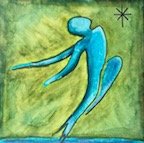Therapeutic Dance and Movement
What is Dance and Movement Therapy?
Dance Movement Therapy is a type of creative therapy that utilizes movement and dance as the means of therapeutic processing.
Movement is something we do 100% of the time. We never stop moving because we are breathing, our hearts are beating, blood vessels pumping and muscles twitching. We are moving from the time we are born (and even before) and for as long as we are alive.
Dancing/movement incorporates mind, body and spirit as well as offers a outlet of creativity and self-expression. Dance or movement therapy can be done in a group or individual therapy format. Dance/movement therapy is not choreographic or skills based. It is about allowing the body to move in the way that feels best for the body and processing emotions or trauma that are being held in the body. The therapist or facilitator may offer suggestions of what movements may be helpful. The therapist may introduce movements or exercises that have the purpose of exploring or connecting with different parts of the body, emotions or different types of rhythms and energy patterns. The facilitator may offer a warm up that includes light yoga and breathing exercises to help regulate the body and nervous system.
Types of therapeutic dance and movement: Dance Movement Therapy, Dancing Mindfulness, Conscious Movement, Ecstatic Dance, Yoga, Yoga Therapy, Adaptive dance, Authentic Movement, Movement Improv, Embodied Movement, Tai Chi, Qi Gong, Martial Arts or more…
What does it Treat?
Depression— Improves energy and mood by releasing neurotransmitters. Increases body awareness, confidence and self esteem.
Anxiety—Provide nervous system and body regulation, reduces hyperarousal by offering calming and grounding techniques, non-verbal ways to process stress and difficult emotions. Social connection. Improving relationship and connection with the body.
PTSD—Provide nervous system and body regulation, reduces hyperarousal by offering calming and grounding techniques, non-verbal ways to process trauma and difficult emotions. Social connection. Improving relationship and conncection with the body.
Who Else Benefits?
Kids/Teens—Emotional regulation, self expression, body coordination and awareness, social connections, non-verbal communication, confidence and self esteem building,
Neurodivergent Folks—Emotional regulation, self expression, body coordination and awareness, social connections, non-verbal communication, confidence and self esteem building,
Elderly—Improve balance and coordination, reduced stress, enhances mood and creates social connections
Those with Eating Disorders—Improves self esteem and self image and encourages better connection with their bodies.
Dancing and Movement is Somatic
Dancing and Movement incoporates and engages the whole body. It teaches clients to listen to their bodies and feel how their body wants to be moving. Feeling safe is a prerequisite for being able to dance and move so often the faciitator will lead the participants in somatic exercises for the purpose of grounding and feeling safe before beginning movement practices. Dance and movement therapy uses the body to help facilitate the processing of emotions.
Dancing and Movement is a Mindfulness Practice
Dancing and movement is a mindfulness practice and it includes the elements of mindfulness:
Nonjudgment: Dancing encourages a person to not judge themselves or others.
Patience: Dancing promotes gentleness with ourselves and others
Beginner’s Mind: Dancing encourages a person to bring an attitude of curiosity and play. Inviting the sense of wonder that a child may have.
Acceptance: Dance encourages us to accept ourselves for who and what we are.
Letting Go: Dancing helps us let go of certain goals or outcomes and release things that we are holding onto.
What does a session look like?
If you are already in somatic therapy, your therapist may at times invite you to engage in a movement exercise. If you enjoy movement work you can let your therapist know and they may offer more movement exercises. Movement can be a great addition to somatic or expressive arts therapy.
Often Dance/Movement therapy is conducted in a group setting which could center around a certain issues like women with anxiety, teens with substance abuse issues or neurodivergent kids.
The class may look like: having a gentle start with light music—the facilitator may instruct the client to sit on the floor and do light yoga-like exercises or a breathing or mindfulness exercises. Then the music may increase in tempo as the body starts getting acclimated to the movements.
No one is ever forced to do anything they do not want to do—everything is ALWAYS optional. There is not pressure to be a certain way or do anything in particular. The facilitators will suggest potential movement experiences that the participants can choose to try or not. The participants are always welcome to engage in whatever movement feels right to them and their bodies and if they need adaptive support, that will be offered. The end of the group will likely be similar to the beginning—a winding down to calm the body down before finishing. The facilitators curate the music playlist to enhance the process but may be open to taking requests.

